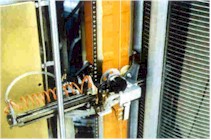IEEE Milestone: RAMAC
Milestone: RAMAC, 1956
Dedication Date: May 26, 2005
On May 6, 1955 International Business Machines Corporation made an announcement that went largely unnoticed outside the computer community and other technical circles. The company reported that a team of engineers working in a small research and development laboratory in San Jose, CA, had developed a new magnetic disk storage technology.
| Few could have guessed in 1955 that the computer industry’s first magnetic disk file, the IBM 350 RAMAC (Random Access Method of Accounting and Control), would one day prove to be of worldwide significance.What the team of IBM engineers had developed was a technology that significantly affected information processing in the worlds of science, agriculture, health, education, government, finance, insurance, transportation, and distribution. This technology ushered in a new era of interactive computer applications such as airline reservation systems, inventory management, automated banking, space flights, word processing, and personal computing. |  |
For more information on this Milestone, see the IEEE Milestone webpage.
CITATION
“Developed by IBM in San Jose, California at 99 Notre Dame Street from 1952 until 1956, the Random Access Method of Accounting and Control (RAMAC) was the first computer system conceived around a radically new magnetic disk storage device. The extremely large capacity, rapid access, and low cost of magnetic disk storage revolutionized computer architecture, performance, and applications.”
____________________________________________________
99 Notre Dame Ave.
San Jose, CA
Note: The IEEE plaque is inside the building. The ASME
Landmark plaque is on the outside of the building.
